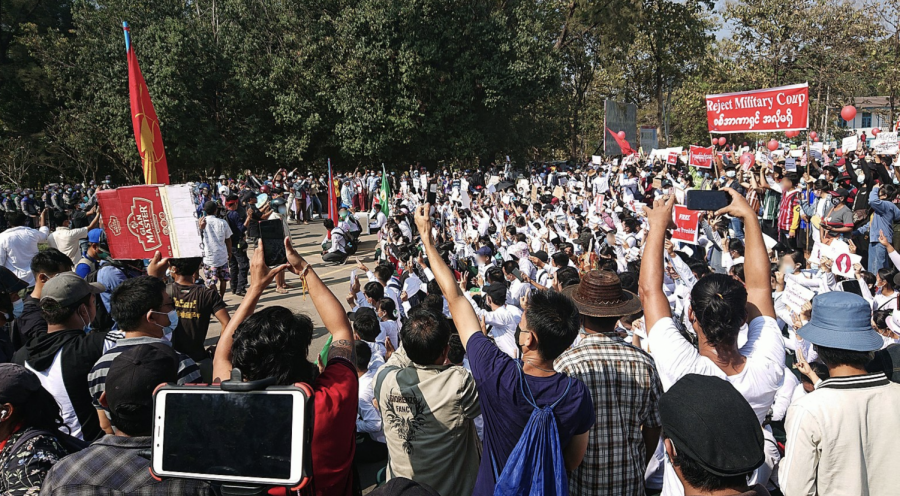Understanding the Myanmar Coup, and Arlington Group’s Response
April 13, 2021
On February 1st, the Myanmar military, led by the Commander in Chief of Defense Services Min Aung Hlaing, took over the Myanmar government. Min Aung Hlaing assumed the role of Chairman of the State Administration Council, making him the leader of the country. Members of parliament were put under house arrest, as well as Aung San Suu Kyi, the State Councilor and an icon of Myanmar’s democracy.
To start to understand this event, one needs to learn more about Myanmar, a country in Southeast Asia. Myanmar was previously a colony of Britain but reached independence in 1948. A coup introduced a military junta in 1968 that continued to rule until 2011 when a democracy was formed. The 2008 constitution, however, maintains the military’s power over elected leaders. A quarter of parliament seats are filled by military appointments, meaning that there can be no constitutional amendments without their support (the threshold for amendments is 75% in favor). The Myanmar constitution also prohibits people with children or spouses that are foreign citizens from becoming president, which disqualifies Aung San Suu Kyi from the presidency. Suu Kyi gained international attention after being under house arrest for 15 years because of her advocacy, and she was given a Nobel Peace Prize for those pro-democracy efforts. However, her standing in the international world has sunken in recent years, due to her defense of the Myanmar military in The International Court of Justice. In 2019, the military was brought under charges of genocide against the Rohingya people, a Muslim ethnic minority. Suu Kyi was criticized for her silence on the topic.
In the 2012 Myanmar election, the National League for Democracy (NLD), the party Aung San Suu Kyi leads, won 43 of 45 available seats. In the following years, the NLD had continued to win by large margins. In 2015, Suu Kyu became the Myanmar State Councilor.
The 2020 elections seemed to be no different. The NLD won 396 out of 476 available seats, and the military party only won an additional 33 seats in addition to its mandatory seats. There was fear and doubt about the election, with both the military party (called the Union Solidarity and Development Party) and international observers voicing concern. The Human Rights Watch, an organization reporting on human rights issues across the globe, called the election “fundamentally flawed,” citing issues of internet shutdowns, laws excluding Rohingyas, and media access.
On February 1st, 2021, the military took control of the government. The military declared a year-long state of emergency, claiming voter fraud. Aung San Suu Kyi and Win Myint (the president of Myanmar) have been removed from their positions of power. On February 3rd, Suu Kyi was charged with breaking the Export and Import law. Leaked police documents showed that the charges stemmed from walkie-talkies found in a raid of her house. The Export and Import Law regulates what can be brought in and out of the country, and has previously been used to charge journalists for flying a drone on an assignment. Win Myint was charged with violating the Natural Disaster Management Law, which prevents campaigning during national disasters, such as a pandemic. His charge is for waving at an NDL vehicle in September. As of the 1st of April, Suu Kyi’s lawyer stated that she has also been charged with breaking a state secrets law, the most serious of all of her charges. A conviction under this law could lead to imprisonment for up to 14 years. Members of the NLD have condemned the arrests and called for the release of the leaders. More than 500 military critics and political figures have been held and arrested.
After the arrests, protests started almost immediately, mostly led by young adults. Myanmar internet providers were instructed to block Facebook, which has been used to organize strikes and protests. The military response has included shutdowns and limits on gathering. Additionally, the protesters have been met with water cannons, rubber bullets, and ammunition. The first confirmed casualty occurred on February 19th, when a young woman who was shot during a protest on the 9th, died. She was shot two days before she turned 20. On February 20th, two more protesters were killed, one of them a 16-year-old boy. On the 22nd, hundreds of thousands took part in a general strike, marching in the streets. The response from the military has continued to grow in severity, and many more have died. Protesters are continuing to fight to get the military to step down. On the 27th of March, death estimates given by human rights groups and news organizations ranged from 90 to 114, with at least six of those deaths being people under 16. The group Assistance Association for Political Prisoners, a nonprofit human rights group, has reported at least 538 deaths since the coup began. Protests are continuing all over the country, and military violence is escalating.
The Myanmar Civil Disobedience Movement (or CDM) is an organization working against the coup. Aye Min Thant, a journalist in Myanmar, spoke in an interview about the goals of the CDM, saying “Some of the main strategic goals of the Civil Disobedience Movement are to try to deny the military regime legitimacy, funding, and cooperation.” Thant went on to talk about the movement for foreign governments to not acknowledge the military’s government and the ways that civil servants and other workers have gone on strike. Aye Min Thant, who has an American passport, ended up having to flee the country for fear of being targeted. It is becoming extremely dangerous for journalists, and many civilians have started trying to document what is happening to raise global awareness.









